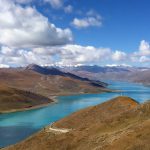October 6, 2018
When you go trekking or climbing in the Himalayas, you are traveling in areas where people have roamed for centuries. Central Tibet is no exception, and the southern route from Lhasa to Shigatse which we followed yesterday has huge historical significance. Back in the 19th and early 20th centuries, the British in India were very wary of the expansion of the Russian empire into Central Asia, including Tibet. Those two counties played what became known as the “Great Game†for many years, as each attempted to thwart the other’s plans.
For the British, reaching Lhasa was important, and they sent Francis Younghusband with an army to open the route in 1904. He traveled north from Sikkim to Gyantse, and then east towards Lhasa. The Tibetans tried to stop him at the Karo La, the 5010m high pass along the way. The battle (or massacre) that ensued was a sad chapter in Tibetan history. Younghusband went on to become one of the champions of the early British Everest expeditions and head of the Royal Geographic Society. If you are interested in this type of stuff, you have some great reading to look forward to.
- Yamdrok Lake from Kamba La (4794m). In the background is the Nojin Kangtsang Range. (Eric Simonson)
- Kalurong Peak (6674m) from the 5010m Karo La Pass (Eric Simonson)
- Barley harvest time on the way to Shigatse (Eric Simonson)
- The Stupa at Gyantse (Eric Simonson)
Yesterday we followed the same route, in the opposite direction. First we climbed up over the Khamba La pass (4794m), then followed the shore of the immense Yamdrok Lake, then crossed Karo La (5010m) before dropping down into the Gyantse valley where the locals were hard at work harvesting barley. Along the way we had great views of the Nogin Kangtsang range with its numerous 6-7000 meter peaks. From there we continued west to Shigatse, the second largest city in Tibet. Today we will visit the Tashilumpo Monastary before continuing to Shegar, another famous old town.
Eric Simonson




